From the Archives, 2009: Black Saturday fires devastate Victoria
The Age
First published in The Age on February 9, 2009
Our darkest day
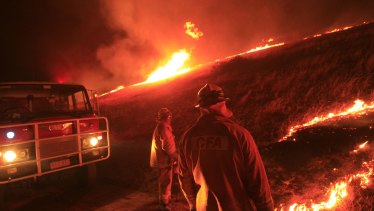
VICTORIA has witnessed this country’s greatest natural disaster. Worse than Black Friday. Worse than Ash Wednesday. That is the grim sum of a catastrophe that already exceeds all others – and which threatens to grow worse.
The towns of Kinglake and Marysville have been wiped out and around the state more people have died than in any previous natural catastrophe – one so lethal that authorities are treating it like a major terrorist attack.
The first of several interstate victim identification teams arrived yesterday to assist Victoria Police under a national terrorist contingency plan.
More than 70 people died in the Black Friday fires of 1939 – and 75 on Ash Wednesday in 1983, 47 of them Victorians. But as the official death list topped 84 last night, senior police sources told The Age they feared the final figure would be much greater.
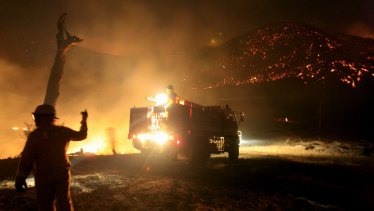
So many bodies are scattered in fire zones around the state that it could take days to find and retrieve them all.
The names of those killed are only just starting to emerge. Among them were former Channel Nine newsreader Brian Naylor and his wife Moiree, at Kinglake West.
Victoria’s morgue was full last night – with hospitals and universities being asked to store bodies until formal identifications could be made. Some of the many injured people in hospital were not expected to survive.
Prime Minister Kevin Rudd yesterday promised help from the army, which has sent bedding to Warragul and heavy equipment to cut fire breaks near Yea.
“Hell and all its fury has visited the good people of Victoria … many good people now lie dead,” Mr Rudd said. “Many others lie injured.”
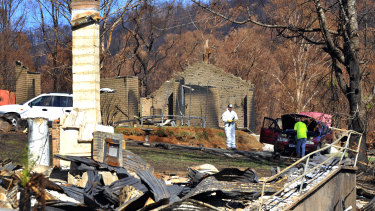
Premier John Brumby launched a bushfire appeal fund in partnership with the Federal Government and the Red Cross. He said the weather conditions that spawned 400 fires across the state were “much worse” than those that produced Ash Wednesday or Black Friday, and he hoped never to see it again.
Schools at Strathewen, Kinglake and Marysville have been destroyed and dozens more will be closed today.
Worst hit was the once-pretty alpine town of Marysville, reduced to a tangled mess of smoking rubble and twisted iron. Most residents were evacuated to nearby Alexandra – itself under threat from fire last night. But some of those who left too late or stayed to fight the fire lost their lives.
The fire that began at the old Murrindindi sawmill near Yea earlier on Saturday destroyed the hamlet of Narbethong and then Marysville, house by house, street by street.
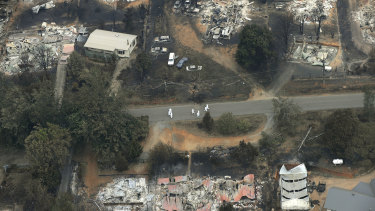
In an hour, Marysville was no more. Every public building including the police station, post office, telephone exchange and much-loved guest houses and a hotel, had been destroyed.
Worse was that some of the gutted cars and buildings had bodies in them. The few locals who stayed and survived talked numbly yesterday of one firefighter’s family being killed, of a pensioner dying at home and of several cars with human remains in them.
Local builder Leigh Jowett saved the old house in which he had grown up – then helped his neighbours save theirs. “There might only be 15 or 20 houses left in Marysville,” Mr Jowett said. “There’s only three left in Falls Road – and the whole main street is gone apart from one motel.”
Former Marysville resident Graham Haycraft was distressed to hear his old family home had been destroyed but counts himself lucky to have moved out.
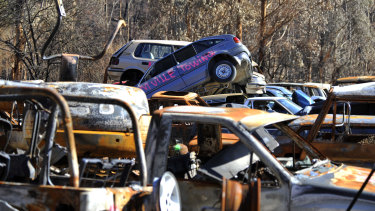
“Marysville missed out in 1939 and on Ash Wednesday, but not this time,” he said last night. “My heart goes out to people who are part of my life.” He expects to return for funerals.
There were similar scenes and stories at Kinglake, at Churchill in West Gippsland and at Bendigo.
Stories of offhand heroism emerged yesterday. Reluctant teenage hero Rhys Sund declined to be photographed after driving a tiny tractor and trailer across country behind the fire front at Chum Creek, near Healesville, to save his sister Rhiannon and a group of frightened women and children from an isolated farmhouse.
“I’m so proud of the young bloke,” Rhys’s father Mark Sund said yesterday. “He cut down the fences in his way and went in.
“Rhys hasn’t been to bed yet. He’s been fighting the fire all night.”
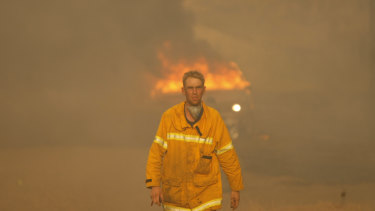
Channel Seven reporter Norm Beaman last night was celebrating his wife Annie’s escape from the Kilmore East fire while he was stopped at a police road block several kilometres from their isolated Mount Disappointment property. Beaman praised the bravery of a local policeman, Peter Gough, who drove a police sedan through burning bush to the farm while Beaman was forced to stay at the roadblock after returning from Melbourne to tackle the fire.
“Annie put up an incredible fight by herself,” he said. “She wet down the house and garden with fire pumps then when the shearing shed and machinery shed exploded she left. She told me on the mobile that she was going to jump in the dam, but she changed her mind and drove to a burnt-out paddock with the neighbours, where they wrapped themselves in wet blankets. That’s where Peter Gough found her. He’s a very brave cop.”
Although the worst might be over, the danger is not past.
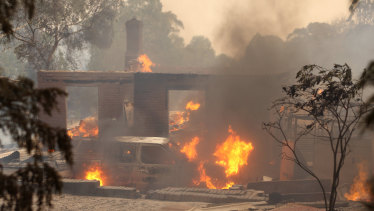
The Bureau of Meteorology has predicted dangerous conditions for much of the week, warning of further lightning strikes and strong winds. Fire danger would still be “very high” from midday to 6pm on most days.
Last night the 30,000-hectare Beechworth fire was causing concern and none of the major fires burning across the state had been contained.
A containment line was still being built around Alexandra to protect it from the fire.
The Kinglake fires were hitting around Glenburn, with concerns for homes along Melba Highway and Yea River Valley, towards Murrindindi.
The Churchill blaze covers up to 33,000 hectares, the Bunyip fire about 25,000 hectares. And a 15,000-hectare fire has started in national park near Dargo.
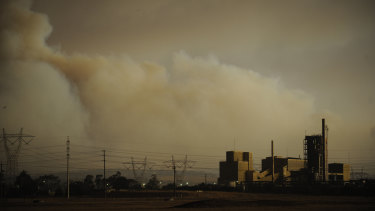
First published in The Age on February 10, 2009
The minnow force that took on a monster
Inferno engulfed bush community in moments
THEY barely stood a chance. The fire that swallowed Strathewen, a community of 200 people on Melbourne’s northern fringe, came with such ferocity and menace and at such blistering pace that it overwhelmed the bushland paradise within moments.
Many who stayed were condemned to a living hell: families caught cowering in their homes, people stranded in cars.
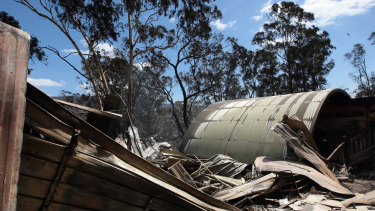
One couple sought sanctuary in their cellar, but above them the house was blown to bits. Another are thought to have huddled futilely in their bathroom.
Another couple fled their home in separate vehicles. The woman survived. Her husband’s car sits abandoned on Eagle Nest Road above the once picturesque oval that lies beneath Sugar Loaf Mountain. His body was found in its barren centre. CFA volunteers would later cut up what was left of the synthetic pitch to cover him respectfully.
It had been chaos. Objects were hurled hundreds of metres. An unexploded 150-kilogram gas cylinder leap-frogged a house and landed in a neighbouring paddock.
Debris and death rolled across the landscape. It was as black as hell, accompanied in those hideous minutes by the roar of what seemed like “every jet engine on the planet”, according to one firefighter. As many as 30 people are thought to have perished, though official identification could take weeks.
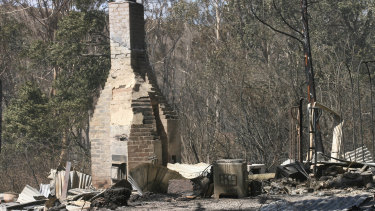
And throughout Saturday’s mayhem, Captain David McGay, chief of the local CFA brigade, which incorporates Arthur’s Creek, and his band of gutsy volunteers – farmers, engineers, public servants, mechanics – were rendered powerless.
“People will often say: ‘The CFA will handle it’. And often we do,” he reflects, amid the devastation. “But I couldn’t do anything. Not a thing …
“I’ve had a few barbs of criticism in the sense that people have said ‘Why didn’t you help me?’ But even if I had had 20 strike teams, all that would have happened is that we would have had 50 dead firefighters as well, me included. That was the scenario.
“In hindsight, it’s just as well I didn’t have those teams because I would have deployed them. But at the last moment I pulled the crews out (three Arthur’s Creek units and a tanker from Doreen Brigade), because we were going to die.”
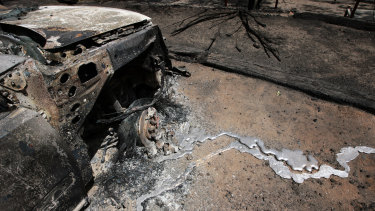
There is a chilling reality that has descended upon many of the bush communities stricken by this disaster. The CFA option to stay and defend, in many cases, proved fatal. And Captain McGay recognises the quandary.
“From what I’ve seen, that message will need to be qualified more,” he says. “People who made provisions to stay with their homes, well, 99 times out of 100 they would have walked away after the fire front had passed. This time, they died. How CFA command handles that is up to them, but this time (staying) was wrong.”
In Strathewen, a commuter community barely 40 kilometres from the CBD, blue-and-white tape identifies the houses and sites where bodies lie, as police investigators and forensic specialists move solemnly between the dead. Outside the restricted zone, the living gather, many prevented from returning to their properties. Their waiting carries its own unique agony: fearing the worst, their grief is seemingly suspended pending official word.
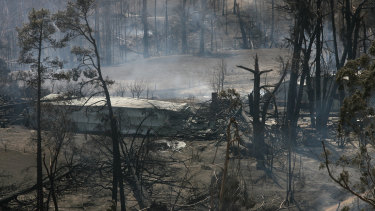
While yesterday’s cooler conditions made Saturday’s climatic contagion all that more surreal, everywhere in Strathewen evidence marks the grim reality. In a paddock, four horses lie side by side, their swollen and tortured bodies like grotesque sculptures. A lemon grove is stick-like, the fruit lying blackened on the ground. The little primary school, only recently the recipient of a $250,000 refurbishment, is gutted. And all about is rubble and wreckage, amid a landscape so scorched and so devoid of life that it’s impossible to believe that the Australian bush’s remarkable regenerative powers could possibly triumph.
Captain McGay battles to check his emotion as his outstretched arm describes a wide arc. “We’ve got four dead there, possibly four more over there, there’s more over there,” he says shaking his head. “Really, it’s probably easier pointing out the places where people survived.”
Remarkably, some did. Just beneath Sugar Loaf as many as 19 people survived in the home of CFA member Barrie Tully and wife Rae. With the help of others, the couple rounded up as many people as possible. The fire took just two minutes to engulf the mountain (which last burnt in 1939), and even less time to scream across the three kilometres to the irrigated oasis that was the Tully’s property.
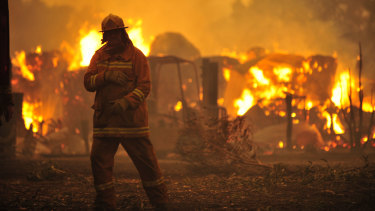
At the last moment, Mr Tully tumbled off his tractor and crawled inside the home on O’Dea’s Road, suffering minor burns only. Geoff Raftery, also a member of the Arthur’s Creek brigade, got inside just as the full force of the fire hit the front door. Brigade pagers marked the moment: 4.20pm on Saturday.
“The force almost blew the door off its hinges,” says Mr Raftery. “The whole thing was miraculous, that anyone survived.”
Some people jumped in dams, one family covering their heads with mud to protect against the searing heat. A heavily pregnant woman, with friends, saved their house with little more than rakes.
Emotions in Strathewen and Arthur’s Creek remain raw, and wretched. Many people harbour a sense that their community has been abandoned – 15 per cent of the community has been wiped out. Noone has been spared misery. But without official confirmation of Strathewen’s toll, Victorians generally have been unaware of the community’s utter despair.
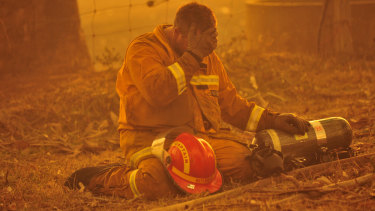
Even Captain McGay, a 40-year CFA veteran and local farmer, sensed a betrayal at the height of the fire. He cannot speak highly enough of his volunteers, several of whom had lost everything but continued to fight spot fires yesterday, as well as those from Doreen. “I would be a little loath to individualise the many acts of bravery,” he says. “My admiration for my crews is so great that I find it difficult to put into words.”
But on Saturday, they were a minnow force that faced a monster. And desperate pleas for back-up went unheeded.
“I don’t underestimate the severity of other areas hit at all,” says Captain McGay. “But Doreen were the only ones who helped us. I was left with my guys and Doreen. That was all we had to fight this holocaust. No matter who I pleaded to and screamed at, we got nothing.”
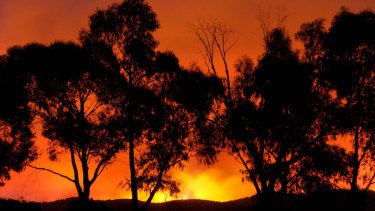
First published in The Age on February 15, 2009
After fear, hope, a town on the road back to life
FROM THE ASHES – REBUILDING KINGLAKE
If the tragedy of the fires has shown one thing, it is that life persists even in the face of death. With kindness, courage and a dose of black humour, Kinglake is beginning the long struggle out of the abyss. Karen Kissane reports.
A BUSHFIRE has its own unexpected beauty. In the evenings, through the smoky haze that hangs over Kinglake, there is a ruby grapefruit moon. Early this week it was full, a round bright salmon globe in the sky. Even the heavens here seem to belong to a different world.
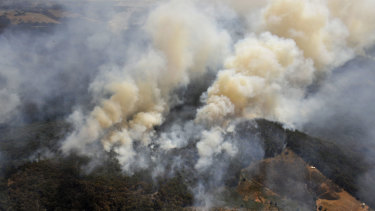
There is a practical explanation for it. Local astronomer Steve Fleming will tell you it is because light is made up of all colours, but as it passes through dust and smoke they are scattered. Red makes it through because it has the longest wavelength. The fact that it can be explained does not make it any less beautiful.
So, too, with the kindness of strangers. The hundreds of men and women who have descended on this beleaguered little town at its time of direst need mostly wear uniforms because they belong to an organisation that has been set up to help. That does not make their wry humour and steady kindness any less sweet.
A woman whose face was covered in a thick, grey crust came into the phone centre set up in a local restaurant this week. She was fine, she reassured others cheerfully. It was just the radiant burns to her face from when she was in the car during the bushfire. The skin had died and would soon slough off. It was only when talk turned to how wonderful the phone technicians had been that she began to cry.
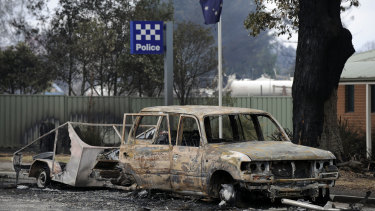
“I feel so humbled,” she said. “So humbled. So many people have come to help us.”
The people of Kinglake have themselves been working ferociously to help their town rise from the ashes. The job of rebuilding life after catastrophic death and destruction has begun.
While soldiers and police discreetly continue the hideous task of recovering bodies from the rubble – up to 400 of Kinglake’s 680 houses are thought to be gone – an army of volunteers feeds not just the homeless but anyone on the mountain who needs a meal. Given that there is still no power, that is a lot of people. Apex member Steve Mead came from Rowville to spend eight hours chopping that day’s 30 kilos of onions for the production line of steak sandwiches, burgers and snags served outside the services office that has become the relief centre. By the end of it he had to have his eyes washed out at the bush hospital that has been set up in a couple of tents. His only gripe was a mock one, made when TV cameras went to pass him by: “No one notices the onion man.”
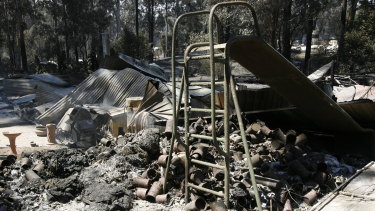
An ice-cream company sends a truck every day with a beaming man who presses free cones on everyone he meets. Schoolkids make their own small gesture. “For you and everyone helping up there,” said the smiley-face note from Emma, who sent a lunchbox of home-made chocolate chip cookies. A lingerie company donated frothy things for women who had lost everything but the clothes they wore. It led to an immortal line from a woman keen to pick some up for a friend. Hands on hips, she demanded of a mutual acquaintance, “What’s her boobage?”
There were lots of bawdy jokes this week. Sex and death, the two Freudian big ones. On Thursday volunteer vet Judith Mulholland was walking around with a tiny, baby sugar-glider in her bra. Every now and then it went walkabout: “No, no, get out of my armpit,” she squawked, clutching at herself. The orphaned bundle of fur, only a few centimetres long, had been found when it scurried across a road and up a firefighter’s boot. He had handed it to Mulholland. “I’m a horse vet. What am I going to do with a possum?” she had protested. Like everyone else up here who is determined to do whatever needs to be done, she worked it out fast.
She missed her baby the next day when he was handed over to the cleavage of a wildlife rescue volunteer, where he was wrapped in a sock and given a syringe of water to suck, providing great material for her comedian mates. “Every man’s dreams,” chuckled one. “He’s got his own airbags,” cracked another.
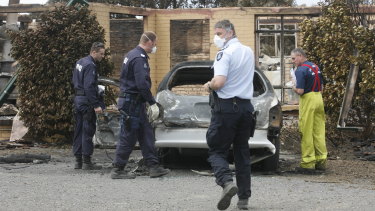
A young mother stopping for a chat confided the highlight of her day: a group of handsome young police dropping their strides as she walked by so they could change clothes. She mimed a vaudevillian double-take: “I thought, ‘Where’s my girlfriend who’s eternally single?’ There were a couple of sets of nice legs, enough to brighten the day, and every woman loves a man in uniform.” Even more so if he is out of it, it seems.
In the midst of death, life.
The reason people can joke is because things are happening to get life back to the new normal. Great convoys of white trucks are rumbling over the mountaintop carrying electricity crews and power poles. There is a huge tanker with fuel in the main street every day decanting 20 litres into individual cars and jerry cans. The Department of Human Services and Centrelink have been in town since Monday helping with emergency payments. Visitors to the relief centre bump into counsellors at every turn. Well-known locals such as Jenny and Peter Beales – she a former guide leader and he a retired policeman – staff the inquiry desk 16 hours a day, helping with everything from generator problems to distressed people who have been given bad news by police.
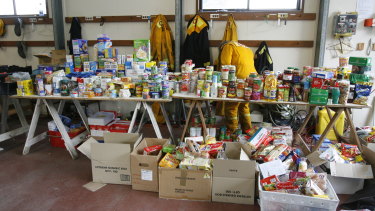
Showers and dunnies have arrived. Police and soldiers are all over the place. The town’s two water tankers have been reinforced with another seven trucks from outside. A mobile youth centre blares out pop music and offers kids computers and video games.
Everyone’s spirits rose with the arrival of a cappuccino machine. Donated food spills out onto the pavement and unpretentious locals don’t know what to make of the mountains of clothes. A farmer asking for new trousers baulked at the stylish jeans handed to him. “They’re good trousers,” he protested. He looked down at his battered work pants: “Haven’t you got something more like these?”
Even people who have lost their homes take sparingly; a pair of work boots, perhaps. They say there are others more in need. That is code for, “I didn’t lose anyone.”
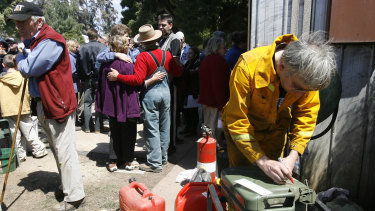
At the centre of the storm of activity is the extraordinary woman running this show: local resident and community leader Anne Leadbeater. Her formal title is community facilitator for Murrindindi Shire. This last week she has been all things to all people: instructing, cajoling, comforting and organising. While running the twice-daily community meetings, she would put the microphone down when she had to weep and then pick it up and barrel on again. The suffering etched on the faces of her audience often brought her undone, partly because it reminded her of her own: two members of her family have lost their homes and dear friends have died.
Spookily, she knows about disaster relief because she has just finished a master’s thesis on the topic. Does it feel a little as if she has summoned the experience she is having? “It does feel like calling down the devil,” she agrees.
In running the recovery effort here, she has kept in mind four principles she learned from Emergency Services Commissioner Bruce Esplin: “You need to tell people what you know, what you don’t know, what we can do and what we need them to do.”
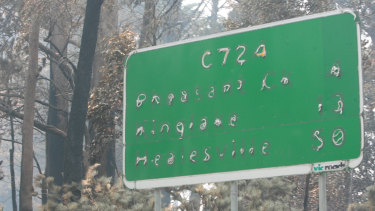
The first and most urgent need was fuel. People were terrified there might be another fire and they had no petrol left to run fire pumps and generators for power.
Next was communications. A Telstra techie slept in his car so that he could stay and help set up a satellite dish and wi-fi. Helpers from off the mountain quickly realised the need to keep it simple. One technician arrived looking neat and tidy with a spiel along the lines of, “Hello, I’m from Telstra and here is what I can do for you.” After 24 hours in a smoke-filled hall full of frightened people at Toolangi, she says, he arrived back at Kinglake red-eyed and dishevelled, just like the natives.
His message had changed to one that could be more easily understood by people in shock who were having trouble processing information: “Phones! Me!”
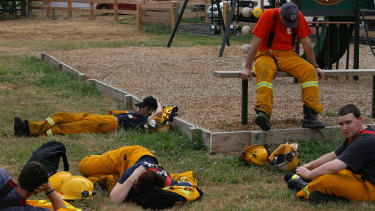
By week’s end, people were starting to think beyond immediate needs. Families who had evacuated have started to drift back. Some older couples have said they would not rebuild; it is too much at their time of life. But families like the Reads, whose three-storey house on Bald Spur Road is a wreck, plan to return.
They were off the mountain at a medical appointment when the fire struck. “Anyone that stayed died, so we were lucky,” says Steve Read of his street. His neighbour managed to get out just in time: “He’s a big bloke, but he got knocked onto the ground when our house exploded 200 metres away.”
Lee-Anne Read can’t look at what remains of her home without weeping. She wandered disconsolately around the block pointing out where her roses and lavender used to be. But Summer, 12, has brought a camera to practise her photography and for Edan, 9, it’s a boy’s paradise full of mysterious artefacts. “We will rebuild,” Steve says. “But we will set up a fire plan and then go if this ever happens again. You can rebuild everything but your life.”
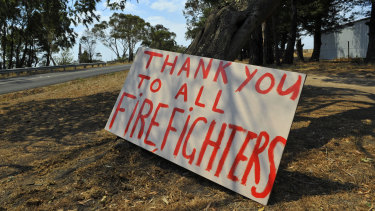
The town remains swathed in a smoky haze from burn-offs, local blow-ups and the fire at Healesville. Patches of ground that have had thousands of litres of water poured on them continue to smoulder menacingly.
Even if there is no second serious fire, there are hard times ahead. Says Anne Leadbeater: “In a sense it’s an empowering thing to stare into the abyss. Everything else must be bearable because we wore that. At the same time you wonder how you are going to bear what is to come. What I am thinking about next is funerals. (It is thought that more than 50 have died here). We will have potentially a funeral a day for a very long time. We have to deal with that as individuals and as a community. It’s going to be very hard.”
But it cannot be avoided: “We can’t say, ‘I don’t want to know about this anymore.’ This is reality now. This is what our community looks like now. We have to forge a new sense of ourselves. I know that we will be OK. I just don’t know what OK looks like yet.”
